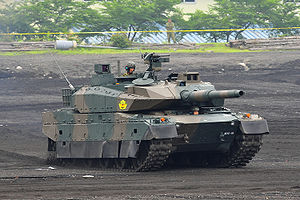Type 10
| Type 10 Hitomaru | |
|---|---|

A JGSDF Type 10 Tank in 2015
|
|
| Type | Main battle tank |
| Place of origin | Japan |
| Service history | |
| In service | 2012–present |
| Production history | |
| Manufacturer | Mitsubishi Heavy Industries |
| Unit cost | $8.4 million (2014) |
| Produced | 2010 (in production) |
| Number built | 80 (FY 2010–2014) |
| Specifications | |
| Weight | 44 tonnes (standard) 48 tonnes (full) |
| Length | 9.485 m |
| Width | 3.24 m |
| Height | 2.30 m |
| Crew | 3 (commander, gunner and driver) |
|
|
|
| Armor | Nano-crystal steel, modular ceramic composite armor, light-weight upper armor. |
|
Main
armament |
Japan Steel Works 120 mm smoothbore cannon with automatic loader |
|
Secondary
armament |
M2HB 12.7 mm machine gun Type 74 7.62 mm machine gun |
| Engine |
4-stroke cycle V8 Diesel engine 1,200 hp/2,300 rpm |
| Power/weight | 27 hp/tonne |
| Transmission | Continuously variable transmission (Hydraulic Mechanical Transmission) |
| Suspension | Hydropneumatic Active suspension |
|
Operational
range |
480 km |
| Speed | Forward: 70 km/h Backward: 70 km/h |
The Type 10 (10式戦車 Hitomaru-shiki sensha?) is a 4th generation main battle tank of JSDF produced by Mitsubishi Heavy Industries for the Japanese Ground Self Defense Force. Compared with other currently-serving main battle tanks in the JGSDF, the Type 10 has been equipped with enhancements in its capability to respond to anti-tank warfare and other contingencies.
The TK-X (MBT-X) project aims to produce the new Type 10 main battle tank, to replace or complement the existing Type 74 and Type 90 main battle tanks that are currently in service with the Japan Ground Self Defense Force. Development began in the 1990s, and production was expected to start in 2010–2011. A prototype was revealed on February 13, 2008 at the Technology Research and Development Institute (TRDI) in Sagamihara. Heavy emphasis was placed on C4I capabilities as well as on performance, firepower, protection and mobility.
In the early 2000s, Japan decided to update its tank force to better prepare for the 21st Century warfare. One of the most important requirements for the new tank is the capability of having C4I (Command, Control, Communication and Computing) system. After assessing the upgrade potential of current Type 74 and Type 90 main battle tanks, Ministry of Defence concluded that there was not enough internal space for C4I system upgrade. Therefore the development of a new main battle tank capable of various future battle missions was necessary.
...
Wikipedia
